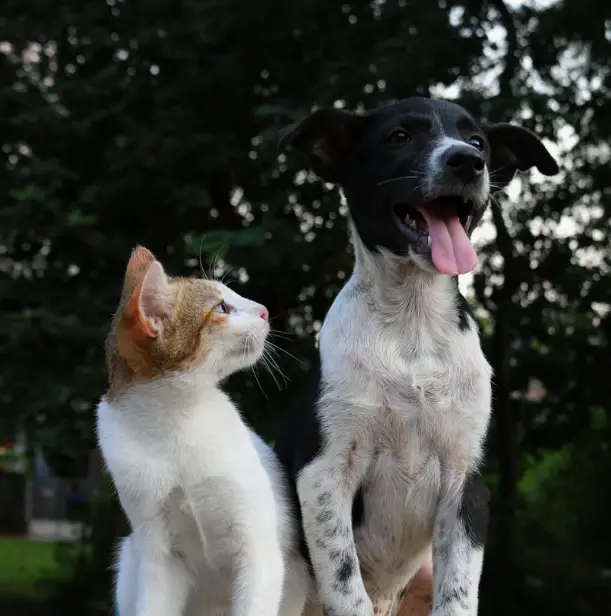If you’re a pet lover like I am, then you probably have a cat or two running around the house at just about any time.
And if you’ve ever had a cat that doesn’t know how to use the litter box or just refuses, then you know what kind of chaos that causes around the home.
Because of the super strong-smelling proteins in cat urine, which is there to mark their territory,
it makes getting the smell of cat pee out of the carpet or even just the floor surface near impossible. ( near)
And for most items, if they get cat pee on them, they’re pretty much done with.
Luckily there are some scents that you can use to help deter your cats from peeing on your belongings.
Of course, you want to get to the root issue and hopefully stop the behavior forever,
But in the meantime, here is a small list of smells that cats will deter cats from peeing:
1. Vinegar
Vinegar is an all-natural cleaner that is not harmful to cats. And it can be used as a deterrent to keep cats from peeing outside of their litter box.
But remember vinegar as a very Stout smell that can overtake your room if you use too much. A white vinegar and water spray solution mixed 3 to 1 water.
You can always add more vinegar but since it’s so strong, starting off small is a better ideal.
2. Eucalyptus
Eucalyptus has a strong menthol smell that cats do not like. It has a similar smell to Vicks. But be aware that Vicks contains an ingredient called camphor that can be poisonous to cats.
You can use eucalyptus oil in a diffuser which may keep the kitty out of the room or you can put it in an eyedropper and sparingly put a few drops in the area that you’re trying to deter the cat from peeing in.
3. Tea tree oil
Tea tree oil has a very sharp menthol odor that cats will try to avoid. It can be used in essential oil in a diffuser or in an eyedropper. A water spray solution can also work. But be very careful to only use a little at a time because the smell of tea tree oil can overpower a room very quickly.
4. Peppermint
Peppermint is also another strong menthol smell that cats do not want anything to do with.
Putting peppermint in the area where you’re trying to deter a cat from being is a great way to not only deter your cat but deodorize the area as well.
5. Coffee beans
Coffee beans or coffee grounds have a smell that cats find offensive.
A small satchel of coffee put in the area where you’re trying to avoid the cat from doing his business can have a great effect at deterring them from doing so.
Coffee is also a nice deodorizer that will not overpower your room or your house as much as say “tea tree oil”.
6. Citrus
The general smell of citrus whether it be in oranges, lemons, or limes, is a big turn-off to cats.
Central oils are very popular essential oil smells as well. You can try diffusing lemon oil in the area that you’re trying to keep the cat from or is a more invasive remedy, use an eye dropper to put a few drops around the area that the cat is prone to.
7. Lavender
Lavender is a calming scent that cats also find offensive. The combination of calming your cat down and deterring him/her from a specific area may not only deter him from going outside of the litter box but calm him down so that he does not want to as much.
Table of Contents
Bodhi 3-in-1 Cat & Kitten Training Aid
Bodhi Three-in-One Cat & Kitten Training Aid with added bitters has been specially designed to teach your kitten or cat to stay clear of the treated areas and discourage the cat from chewing things inside your home, both inside and outside. Stop cats from sitting, wandering around, jumping, scratching, or chewing furniture, carpet floors, wood flooring, or drapes around the house! Spray areas where you want to deter your cat. Reapply the spray at least every twenty-four hours until your cat’s habit has been broken. The rate of application is contingent upon how bad the cat’s behavior is and the frequency with which the cat is in the area. 3 in 1 Cat & Kitten Training packaging is produced with the most sustainable and environmentally friendly methods accessible from the USA. MADE IN THE USA
Harbors Cat Repellent and Trainer – Cat Repellent Spray
Harbor’s Cat Repellent Spray helps train the cat to stay clear of the area or object sprayed. It’s a learning process. The cat will go to the location where the repellent was sprayed and discover that the location is unpleasant, and then go away. It could take several visits before the cat discovers that it doesn’t like the location.
It’s a Learning Process
Harbor’s Cat Repellent Spray acts as an aid for cat training. It comprises three scents that you’ll enjoy, which your feline will be able to avoid. Help your cat avoid being in trouble.
To get the best outcome, apply three times every day for seven days and repeat as required. If you try applying the repellent or trainer only one or two times and expect results to be immediate, the result may be disappointing… Additionally, certain materials may require many applications before they build up enough scent to repel cats (non-porous surfaces may take more time).
NaturVet – Off Limits Training Spray
Stop pets from causing damage to outdoor and indoor areas If your pet is chewing furniture or digging up yards and patios Help them stop by spraying them with NaturVet Off Limits pet Training Spray for cats and dogs.
- HELP prevent pet digging Problems with dog chewing: NaturVet Off Limits pet Training Spray for dogs and cats provides pets with solutions made of herbs that can help reduce the damage to patios, furniture lawns, and gardens.
MINIMIZE the amount of chewing your pet does by using a non-toxic spray: This easy to apply spray for pets is stain-free and non-toxic, so it won’t cause irritation to your pet’s skin or cause staining to furniture. The cat spray for chewing is suitable for use both outdoors and indoors on all surfaces that can be cleaned.
Nature’s Miracle Just for Cat Stain and Odor Remover
- The Nature’s Miracle Urine Destroyer for cats is resistant to strong cat urine as well as the sticky, yellow product that goes with it.
- The formulas based on bacteria produce enzymes when they come in contact with food sources like urine, feces, vomit, and other bio-based wastes. The enzyme cleaner will continue functioning as long the food source is in the vicinity, leaving the area with a fresh, light smell.
- Always use the maximum power. Don’t dilute.
- Get rid of stain: Clean off the stain as thoroughly as possible. Then, after you thoroughly wash off your hands of the stain.
- Odor elimination: Clean any odor-producing materials. Then thoroughly soak the affected areas. The importance of saturation is to make sure that the product can penetrate deep into the source of the smell.
There are many reasons why a cat may not use the litterbox. A few of the more common reasons are:
Scent – Cat’s have sensitive noses and will often refuse to eliminate in an area where another animal has urinated or defecated. If you have other pets, try changing their litterboxes to see if it helps. This is especially true if you have dogs as cats and dogs may get into territorial disputes.
Litter Box – Make sure that your cat can easily access the litterbox by making sure that it is not blocked by anything such as furniture or toys. Also, make sure to keep the litterbox clean and that there is enough litter in it for your cat.
Make Sure That The Litterbox Is Big Enough – If your cat just started using a new box make sure that the box is big enough for them. Some cats won’t use a box that is too small for them because they don’t feel comfortable doing their business in such a confined space.
Location – Try putting the litterbox in different places in your home to see if your cat will use it because of its location. For example, some cats prefer boxes that are more secluded so moving it to a more private spot could help them feel more comfortable using it
Cats are clean animals by nature, and most will learn to use a litterbox if you give them one. The main reasons for litterbox problems are that the cat is uncomfortable with the box location or type of litter, or there is a medical problem.








